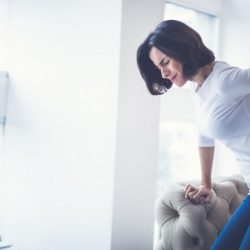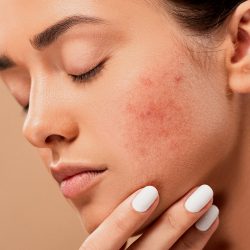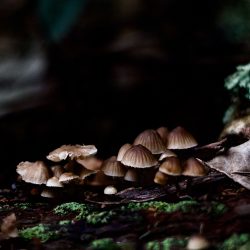A herniated disc is the protrusion of an intervertebral disc or its nucleus outside its normal limits. In France, this condition affects men more than women, mainly between the ages of 20 and 30. A disc is made up of a gelatinous nucleus, the nucleus pulposus, and an envelope of peripheral fibres that connect the two vertebrae. After repeated violent strain on the back, this envelope may crack, allowing the nucleus to protrude. One of the immediate consequences is stress on one or more nerve roots or on the spinal cord, with varying degrees of pain (sciatic neuralgia, cervicobrachial neuralgia), or even paralysis of the organs corresponding to these roots (limbs).
What is a herniated disc?
Herniated discs cause pain in the lower back, legs, shoulders or arms. Caused by compression of a nerve by an intervertebral disc, they usually heal spontaneously within a few weeks. In 90% of cases, herniated discs occur in the lumbar vertebrae, with symptoms affecting the lower back or one leg. This is lumbago and sciatica pain. In 8% of cases, the herniated disc occurs in the cervical vertebrae, causing pain in the shoulder and arm.
Are there any complications from herniated discs?
Although painful, herniated discs rarely cause complications. Compressed nerve fibres, when they are sensory (those that transmit touch and pain), recover well from compression once the disc is back in place.
However, in some cases, the hernia compresses the nerve fibres that control the muscles (“motor” fibres). These recover poorly from compression, which can lead to lasting paralysis. In this case, the compression must be removed as quickly as possible, by urgent surgery.
A sudden reduction or disappearance of pain due to a herniated disc may be a sign of worsening compression of the nerve and damage to the motor fibres. In addition, weakness in an arm or leg, or the inability to walk on tiptoes or heels, may be a sign of damage to the motor fibres innervating the leg. In the arm, compression of the motor fibres can result in a loss of dexterity in the fingers.
Another type of complication:
Another complication of herniated discs is chronicity, i.e. regular suffering from the same herniated disc. This is particularly common in people who do not engage in regular physical activity, those who are overweight, and those who suffer from depression or chronic stress, for example at work. Conflicts, such as those within a hierarchy or within a couple, are also thought to contribute to the recurrence of herniated discs and to their becoming chronic.
What causes a herniated disc?
There aremany causes of a herniated disc, and more often than not, several of them need to come together for the condition to appear:
- Drying out of the intervertebral disc, most often due to age, and sometimes aggravated by poor hydration of the body (for example during hot weather).
- Wear and tear of the intervertebral disc due to repeated efforts, poor posture, prolonged sitting day after day, etc. An area of the disc is then subjected to intense and repeated pressure, making it more fragile.
- A family background that makes intervertebral discs more vulnerable, due to their morphology or poor spinal posture.
- Trauma that damages the disc or suddenly subjects it to very intense pressure.
Contrary to a widespread misconception, stress and anxiety cannot cause a herniated disc. However, they can contribute to maintaining the problem and turning it into a chronic illness.
Some naturopathic advice for protecting your back from a hiatal hernia
Healthy lifestyle measures should be put in place and scrupulously followed to avoid recurrences and the onset of chronic pain.
Adopt a healthy lifestyle:
- Start weight training: It’s best to seek the help of a trained professional (sports coach, physiotherapist, kinesiologist).
- Drink enough fluids in hot weather.
- Maintain a healthy weight or lose weight if you are overweight. A body scan such as InBody gives you a true picture of your body composition, unlike conventional scales.
- Take time out to relax.
- Avoid smoking.
- Watch your weight.
Posture techniques to prevent back pain linked to herniated discs
-
Constant postural awareness
- Maintain an upright posture: back aligned, shoulders repositioned backwards.
- Keeping your eyes straight is important.
-
Lift objects correctly
- Avoid leaning forward or twisting your torso when lifting a heavy object.
- Use a proper lifting technique: bend your knees and keep your back straight, holding the object close to your body.
-
Gestures adapted to everyday activities
- Example for shovelling: keep your back straight, hand close to the shovel, knees bent, and use your legs as a lever.
- Avoid twisting your back when shovelling snow.
-
Adopting preventive measures
- Choose positions and movements that minimise pressure on the intervertebral discs.
- Carry objects against your body rather than at arm’s length, and push rather than pull heavy objects.
-
Listen and react to body signals
- Pay attention to the first signs of back pain, which are often precursors of a herniated disc.
- Interpret these signs as warnings so that you can take preventive action.
Improving posture at work to prevent herniated disc pain
-
Standing posture
- Use a low stool to rest your feet alternately every 5 to 10 minutes.
- Alternating helps reduce pressure on the back.
-
Sitting posture
- Regular breaks for stretching and movement to prevent stiffness.
- Use straight-backed chairs that support the lower back.
- Adjust the height of the chair so that the knees are slightly higher than the hips.
- Prefer a swivel chair to reduce twisting.
-
Everyday tips
- Prefer backpacks to handbags, carry them on both shoulders for balanced weight distribution.
- Push rather than pull heavy objects.
- Avoid high-heeled shoes (over 5 cm), opt for comfortable, well-fitting shoes that offer good support.
Can sport relieve back problems caused by a herniated disc?
The answer is YES. In fact, recent scientific studies highlight the importance of physical exercise in the treatment of herniated discs. Here is a summary of the main findings:
- Management of Lumbar Disc Herniation: A systematic review highlighted that the initial treatment of lumbar disc herniation is conservative, with the frequent use of paracetamol and anti-inflammatory drugs to relieve pain. Regular exercise is recommended for long-term pain relief, as well as for speeding up recovery from surgery, which is essential for maintaining a high quality of life and avoiding loss of earning potential.
- Necessity and Timing of Exercise After Lumbar Disc Herniation Surgery: A study evaluated the effect of early and late rehabilitation on low back pain and quality of life after unilateral microdiscectomy. The study showed that regular exercise is highly recommended for long-term pain relief, as well as for rapid recovery after surgery, which is crucial for maintaining a high quality of life and preventing loss of earning potential. Early implementation of exercises is ideal, but even if initiated later, standard back exercises can still speed up rehabilitation.
- Effect of Lumbar Stabilisation Exercise on Disc Herniation: Another study examined the effects of pelvic movements on back function in patients with lumbar disc herniation when lumbar stabilisation exercise was applied. The results showed a significant improvement in the disc herniation index, sacral angle and back function after the intervention. Lumbar stabilisation exercises, which control balance using pelvic movements, not only improve proprioceptive sensitivity, but also have positive effects on the recovery of lumbar disc function.
These studies highlight the crucial role of exercise in the management of lumbar disc herniation, particularly with regard to post-surgical rehabilitation and long-term pain management. It is essential to note that these exercises must be undertaken under professional supervision to ensure their effectiveness and safety.
Specific strength training exercises for herniated discs:
| Category | Specific exercises |
|---|---|
| Core strengthening | 1. Plank: Lying face down on the floor, support yourself on your forearms and toes, keeping your body straight and rigid. Hold the position for 30 seconds to a minute.
2. Bird Dog (Alternating arm and leg raise): On all fours, raise and extend one arm and the opposite leg, hold, then switch sides. 3. Bridge: Lying on your back with your feet flat on the floor and your knees bent, raise your hips by contracting your buttocks. Hold the position, then lower back down. |
| Stretching and mobility | 1. Cat-cow stretch: On all fours, alternate between rounding your back upwards (cat) and lowering it (cow), following the rhythm of your breathing.
2. Seated trunk rotation: Sitting on the floor with your legs straight, turn your upper body from side to side, keeping your back straight. 3. Child’s Pose: Kneel on your heels, stretch your arms forward and rest your forehead on the floor, stretching your back. |
These exercises are selected for their effectiveness in strengthening and stretching the lumbar region and trunk, which is crucial in the treatment and prevention of disc herniation. It is advisable to consult a health professional before starting any new exercise programme, especially in cases of disc herniation, to ensure that the exercises are appropriate and performed correctly.
Medicinal plants effective for herniated discs
Herniated discs are caused by compression of a nerve by an intervertebral disc, and usually heal spontaneously within a few weeks. Treatment is based on relieving pain and inflammation. Surgery is rarely necessary.
Essential oil of Chamomile matricaria flowering aerial parts:
Analgesic, pre-anaesthetic and anti-inflammatory, this essential oil is generally indicated for herniated discs, muscle strains and rheumatic fever.
Standardised extract of White Willow bark:
White willow is an anti-inflammatory, acting on IL-1 beta and NF kappa B (reducing IL-6 and TNF-α), reducing the infiltration of polynuclear cells, smoothing the synovial mucosa, protecting against the formation of osteophytes, reducing soft tissue swelling and bone resorption. It also reduces levels of inflammatory mediators.
In fact, it is an excellent analgesic for pain caused by herniated discs.
Harpagophytum glycerol fluid extract:
This plant is a powerful analgesic with anti-inflammatory activity through inhibition of cyclooxygenase-2 (COX-2), effective in the pain of herniated discs.
The best natural painkillers available online:
| Product name | Key ingredients | Properties |
|---|---|---|
| Nature Dolgi Flash PEA | Palmitoylethanolamide (PEA) | Natural analgesic, relieves neuropathic and inflammatory pain |
| Pure Encapsulation Curcumin | Curcumin | Powerful anti-inflammatory, helps reduce pain and inflammation |
| Solaray Boswellia & Harpagophytum extract | Boswellia, Harpagophytum | Relieves joint and muscle pain, anti-inflammatory action |
| Arkopharma Chondro-Aid Flash Caps | Turmeric, Boswellia Black sesame | Supports joint health, reduces inflammation and pain |
| Serrapeptase Bionops Natural Anti-Inflammatory | Serrapeptase | Proteolytic enzyme, reduces inflammation and oedema, relieves pain |
| Soria Natural Curcumin anti-inflammatory | Curcumin | Anti-inflammatory, antioxidant, helps manage inflammatory pain |
Medical literature and clinical trials:
- Acute common lumbosciatica, Vidal Recos, 2016
- Eur Rev Med Pharmacol Sci . 2023 Oct; The necessity and timing of exercise after lumbar disc herniation surgery
- J Phys Ther Sci. 2017 Dec;29(12):2121-2125. doi: 10.1589/jpts.29.2121. Epub 2017 Dec 7.
Effect of lumbar stabilization exercise on disc herniation index, sacral angle, and functional improvement in patients with lumbar disc herniation - Cureus . 2023 Oct 29;15(10):e47908. doi: 10.7759/cureus.47908. eCollection 2023 Oct. Management of Lumbar Disc Herniation: A Systematic Review







